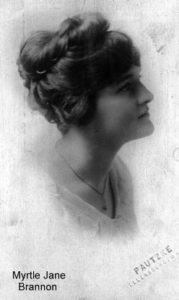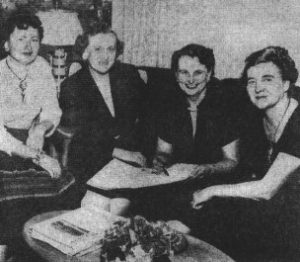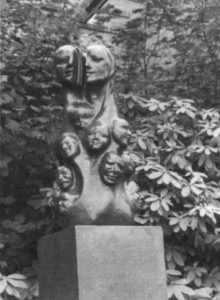Children’s Advocate and Community Leader
 By Margaret Riddle
By Margaret Riddle
Myrtle Jane Brannon Ferrell arrived in Everett as a young bride in 1931, one of the darkest years of the Great Depression. Banks were failing, unemployment was high and government relief programs had yet to be initiated. Communities depended on dedicated volunteers to give aid and Myrtle—recently married to Everett physician Lewis J. Ferrell—decided to help. Myrtle volunteered with the Red Cross. Thus began 44 years of community service that included work with the Snohomish County Visiting Nurses’ Association, attending a White House conference on children and youth, teaching Sunday School at Trinity Episcopal Church and significant work with the Everett chapter of the American Association of University Women. Myrtle also served on the Everett School Board for more than twenty years. In 1953 the Everett Business and Professional Women’s Organization honored her as “Woman of the Year in Achievement.”
Born in 1899 and raised in Chicago, Myrtle was the second of nine children born to Charles and Bertha Brannon. By the 1920 census, the Brannons were living in Valley, King County, Washington. That same year census counters found Myrtle also boarding in Lewis County, perhaps as she began her studies at Central Washington State College. Myrtle completed her bachelor’s degree at University of Washington with a major in Sociology. She taught school for a few years after graduation, then enrolled at the University of Chicago where she earned a master’s degree in medical and psychiatric social work. Here she met and married Lewis J. Ferrell. Perhaps family ties brought Myrtle back to the Northwest and Lewis began his medical practice, a Women’s and Children’s Clinic, in Everett’s Medical Dental Building.
Had Myrtle wanted to teach in Everett, she couldn’t have. Married women were not allowed to be teachers until after WWII. While there were certainly exceptions to this rule, Myrtle instead used her skills in volunteer efforts and, after her sons were grown, became her husband’s business manager and partner, a position typical of other husband/wife professionals at the time.
Myrtle worked continually for children’s causes and was chosen to attend a White House conference on children and youth as well as being appointed by the State Superintendant of Public Instruction to a special committee on disadvantaged and gifted children. But nowhere was her love for children more evident than toward the Ferrells own two sons, Philip and Barry. Myrtle balanced her time between family and volunteer work. Phil recollects times when his parents entertained he and his brother by staging “Mom and Dad Shows”, Myrtle and Lewis playing the parts of personalities like Alberto Roselini and Ingrid Bergman. Lewis created stories for the boys, one particular series was with Ezra, a mouse with an electric tail. Phil and Barry remember their home life as joyful and creative. When Barry was a Cub Scout, Myrtle served as den mother for five years. When the boys met at the Ferrell’s home, she would frequently bake them fresh bread.


But the AAUW was a steady and continuing part of Myrtle’s life. She had been the chapter’s founder in 1940, served as its president for three years and remained active in the group until her death in 1975.
Here Myrtle joined other women in working for important issues of the day. Myrtle put it this way: “AAUW is the greatest organization I know. It gives you an opportunity to keep up on local, state and national and international affairs.”
The Ferrell’s often opened their Rucker Hill home for AAUW meetings and teas. Myrtle’s leadership ability led her to the position of State Division President and Vice President of the North Pacific Regional AAUW in 1949, the year Seattle hostessed the National AAUW Convention. Over the years Myrtle held many offices with AAUW, attended the group’s International Federation Conference and in 1967 was appointed to a topic implementation committee for “Politics of Public Education”, representing the Everett chapter at a national level. This position took her to Washington D.C. in January of 1967.
In 1942 Myrtle established an AAUW fellowship fund for promising young women. The national AAUW had begun the program to aid young women in their scholarly pursuits. Local chapters raised funds for scholarships and administered the giving in their own communities. Myrtle became one of the group’s most active fundraisers.
In the 1950s Myrtle Ferrell made an unsuccessful try for a house seat in the Washington State legislature but local politics turned out to be her place. In 1950 she ran for the Everett School District Board and easily won. She remained on the board until shortly before her death, serving four terms as board president. Through the ‘50s and ‘60s new schools were built and enrollment expanded. There was no strong local teacher’s union then and board members were sought for advice.
But by the early 1970s the economy was in recession, unemployment was high and school enrollment was declining, especially in the north and central neighborhoods. In a cost-cutting move, Washington Elementary was closed. In both 1971 and 1972 the district lost its spring special levy elections. The board was faced with crisis decisions and the newly-formed teacher’s union, Everett Federation of Teachers #772, struggled with the board over issues including a pending layoff of 200 teachers.
Now in advancing years and declining health, Myrtle decided not to run for re-election in 1973. But she was persuaded to run—most likely a disservice to her—and was defeated by Robert Daoust, a candidate with teacher union support.
Remembering Myrtle Ferrell
Lewis died unexpectedly in January of 1975. The couple had been close partners for 44 years. An ailing Myrtle soon was moved to Bethany Home where she died of a stroke in August that same year, three months before her 76th birthday. When asked what he remembers most about his mother, Barry mentions that she was a woman of strong Christian faith. Myrtle clearly did not preach to others but instead believed in living her life as a good example. Her death was a great loss to the family.
AAUW friends also grieved and a committee was formed to decide on a fitting memorial to honor their founding mother. Proposals were made to have a park named after the Ferrells or the swim center at Forest Park or a school named for Myrtle. All suggestions were rejected. Artist Carol Hasford was commissioned to create a sculpture which officially was placed in front of the Everett Public Library in 1977. A few years later the sculpture was vandalized beyond repair and not replaced.
At the time of this writing, the only public tribute that remains is a photo of Myrtle that hangs in the children’s room at the library. As the written word often outlasts other memorials, it is hoped this piece and other writings contributed by her friends and journalists over the years—assembled and carefully ordered in the excellent scrapbooks of Everett’s AAUW—will continue to tell of Myrtle Ferrell’s legacy.
Sources:
Georgette Cook, “Humanitarian”, Letter to the Editor, Everett Daily Herald, August 20, 1975; “Mrs. Lewis Ferrell Named ’53 Woman of Achievement,” Ibid., April 14, 1953; AAUW scrapbooks, particularly a notebook assembled by Kandace Aksness of events and news stories relating to Myrtle Ferrell; phone conversation with friends Jean Spencer, Gwen Anstis and Lee Ruck, December 28 and 30, 2008; email conversation with David Cameron who consulted Labor Journal notes regarding the 1970s teacher’s union activities; phone conversations with Philip and Barry Ferrell, January 29 and 30, 2009
© 2008 Margaret Riddle, All Rights Reserved
